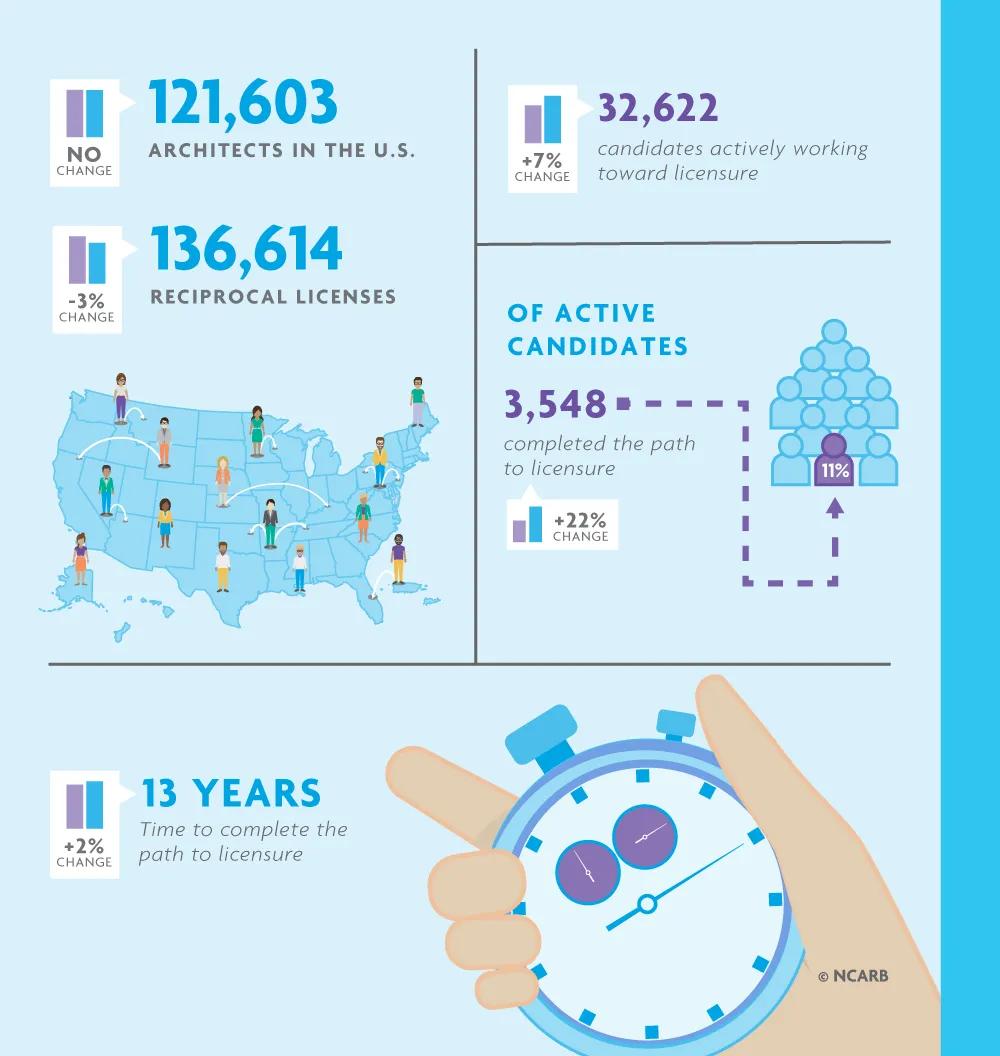
While the COVID-19 pandemic continued to impact the architecture profession during 2021, the number of U.S. architects held steady. There are just over 121,600 architects licensed across the 55 U.S. jurisdictions. Those architects also hold roughly 136,000 reciprocal (out-of-state) licenses—a slight decline compared to 2020.

The number of candidates working toward completing the path to licensure rose by 7% in 2021, with over 32,000 reporting experience, taking the exam, or both. With exam availability no longer impacted by COVID-19 safety precautions, the number of candidates completing the path to licensure also began to rise toward normal levels. Over 3,500 candidates finished the licensure process in 2021, just under 11% of the total candidate pool.
And at 13 years, the average time to earn a license is a few months longer than it was five years ago.
The number of architects licensed in the United States held steady in 2021 at 121,603—about 300 fewer than the number seen in 2020, according to data from NCARB’s annual Survey of Architectural Registration Boards.
The number of architects has been steadily rising over the past five years. The slight reduction seen in 2021 is likely due to the COVID-19 pandemic, as the historically low number of new architects seen in 2020 and 2021 may not have been sufficient to offset the number of existing architects retiring from the profession.
In addition, the Survey of Architectural Registration Boards indicated that the number of reciprocal licenses held by U.S. architects fell by 3% in 2021. This is still higher than the number of architects in the United States, suggesting that the average architect is licensed in more than one jurisdiction.
Regulators and legislators frequently use data related to reciprocal licenses as an indicator of mobility in licensed professions. Despite 2021’s slight downward trend, the number of reciprocal licenses and the fact that the average state issues more reciprocal than resident licenses indicates that the current path to mobility in the architecture profession remains effective and accessible.
While the number of architects licensed in the United States has risen 7% in the last five years, the total U.S. population has risen just 2%, according to data from the U.S. Census Bureau.
This means that there are now slightly more architects per capita (roughly 1 architect to every 2,730 people) than there were in 2017 (roughly 1 architect to every 2,860 people).
Note: Many architects maintain their professional licenses into retirement, which could also impact this data.
Following the pandemic-related drop in active licensure candidates seen in 2020, the number of candidates working toward licensure rose by 7% in 2021.
In 2021, over 32,000 candidates made progress on the path to licensure. This included 16,437 reporting experience, 12,400 taking the exam, and 3,785 both reporting experience and taking the exam. The proportion of candidates making both AXP and ARE progress in 2021 rose from 11% to 12% in 2021, this remains smaller than the proportion seen in 2017 (15%).
In 2021, just over 3,500 candidates finished the path to licensure, a 22% increase compared to 2020. The path to licensure includes earning a degree from an accredited architecture program, as well as the national experience and examination programs. Completing these key requirements for licensure is a reliable indicator that an individual has become (or will soon become) licensed in a U.S. jurisdiction.
Following record high numbers of candidates completing the licensure path in 2016 and 2017 due to programmatic changes, the number of licensure candidates dipped dramatically in 2020—a result of the pandemic’s impact on candidates’ AXP and ARE progress. 2021 data suggests a recovery toward normal levels, although the continued decline in AXP completions may result in future declines in the number of candidates ready for licensure.
Note: Some jurisdictions have additional licensure requirements, such as a supplemental exam.
From beginning their first college degree to finishing their final licensure requirement, the average candidate who completed the path to licensure took 13 years to do so—four months longer than the time seen in 2017.
On average, 7.1 of those years were spent completing NCARB’s experience and examination programs.
Note: Historical data can shift because licensure candidates can backdate experience up to five years.
